Blog
How to Fix a Clogged Drain: The Definitive Guide
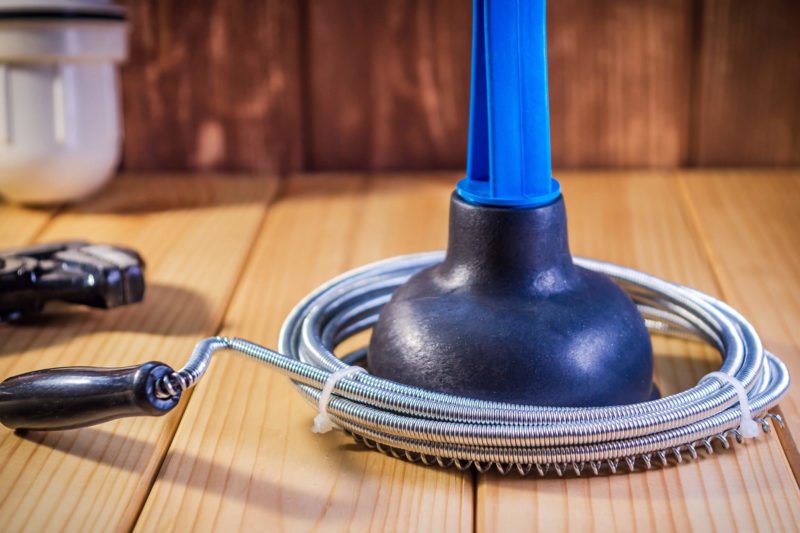
Drain clogs are perhaps the most common plumbing issue homeowners in Cincinnati face. Fixing a clogged drain is often simple and solved with DIY measures.
With our definitive guide, you too can learn how to fix a clogged drain line and plumb like our professionals! Our plumbing staff has compiled this comprehensive guide that details how to fix a clogged drain pipe in your home’s bathrooms and kitchens so that when clogs occur, you are able to clear them quickly.
When a drain clog jams up your plumbing lines, don’t let the problem linger; doing so just opens the door for more extensive issues. If these instructions don’t fix the clog, please call Apollo Home immediately for professional drain cleaning and clearing services.
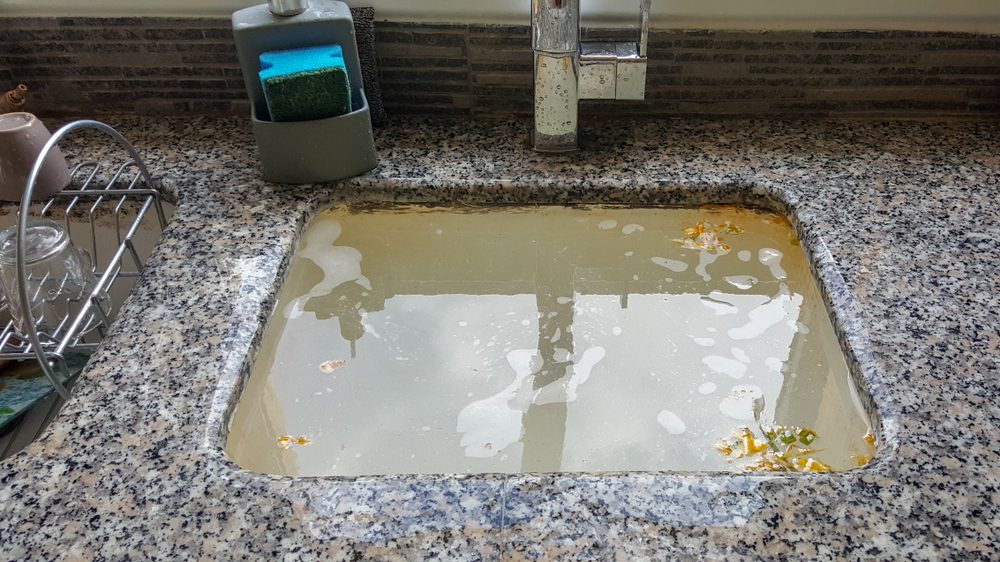
DIY Drain Clog Fixing vs. Calling a Plumber
It’s fairly easy to spot a drain clog–water drains slowly or doesn’t drain at all. For many homeowners, their first inclination is to grab a plunger and get to work, but not all clogs can be cleared using at-home methods.
If you know when to leave drain clearing to a professional, you save yourself some hassle and limit the wait for restored drainage. These signs tell you that the clog in your lines is too much for you to handle–call your plumber for repair.
- When more than one drain runs slow: Multiple sinks or pipes not draining usually aren’t a coincidence–most likely, you have a single clog below where the drainage pipes meet, perhaps even in the main line.
- When clogs keep occurring: Unclogging a shower or sink drain is usually a relatively easy task, but any clog that doesn’t get resolved after frequent attempts should be checked by a plumber. When a drain malfunctions repeatedly, it’s a sign that the entire clog isn’t being removed or that the blockage is located deep in the lines where it’s impossible to eliminate without specialized equipment.
- When water backs up into another drain: For instance, if you find standing water in your utility sink when you’re doing laundry or water backs up into your bathtub or shower when you flush the toilet, you likely have a main line clog. In this case, addressing your home’s individual fixtures does not help.
- When your drains smell like sewage: It’s normal for a kitchen drain to develop a foul smell on occasion, and smelly garbage disposals are usually easily resolved by putting lemon peels, baking soda, or vinegar down the drain. Your main line may be backed up if this doesn’t resolve the smell.
- When water backs up into your basement: Standing or bubbling water around a basement floor drain clearly indicates a blockage issue that deserves immediate attention.
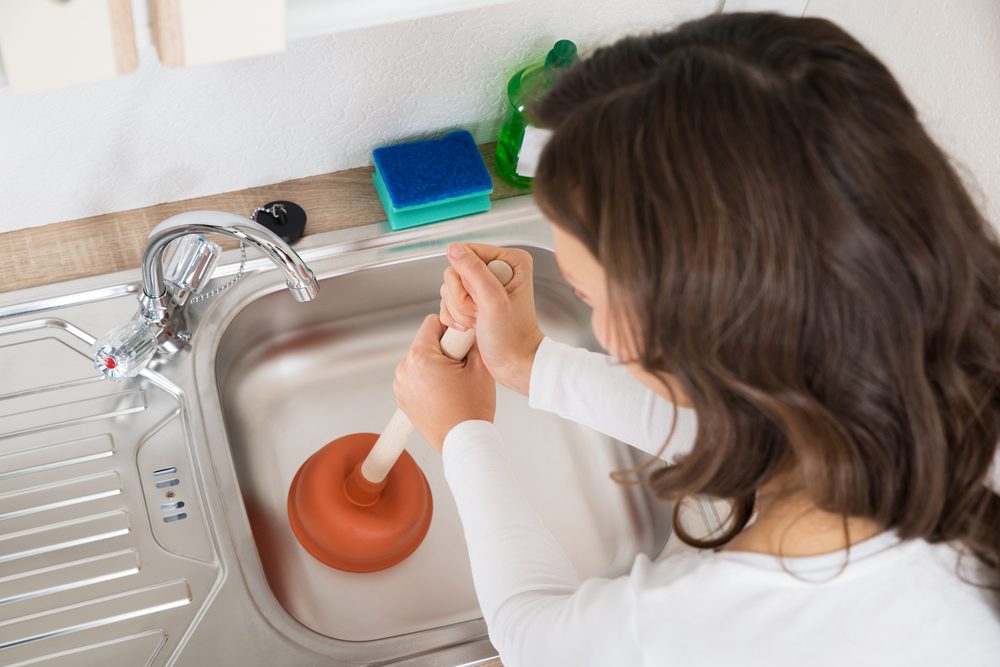
Items You’ll Need to Fix a Clogged Drain
A few basic plumbing tools are needed. These tools are available for purchase at your local home improvement store.
- Cup plunger
- Flanged plunger (also called a toilet plunger)
- Drain snake (also called an auger)
How to Unclog a Bathroom Drain
Follow these steps to fix a backed up drain:
- Remove the drain stopper to see if you can determine what is blocking the drain.
- If the clog is visible, use your fingers, pliers, or a wire coat hanger to remove the blockage.
- If you can’t reach the clog, run hot water down the drain for a few minutes. This can dissolve the debris that is blocking the pipe. If hot water doesn’t do the trick, try pouring boiling water down the sink–but only if you are certain that your pipes are metal and not plastic PVC, which can be damaged by boiling water.
- If the sink is still not draining well, you need to use a plunger to clear the clog. A standard cup-style plunger is the tool you need–it’s dark red in color with a flat, wide rim and comes in various sizes. Small ones are best for sinks, while larger ones work best in showers and bathtubs. A flanged (toilet) plunger is not as effective in a sink, shower, or tub.
- Seal the overflow outlet by covering it with a washcloth or piece of waterproof tape.
- Fill the sink with water–just enough to cover the top of the plunger.
- Center the plunger over the drain, creating a strong seal.
- Pump it several times to create a vacuum. The suction loosens the clog and allows it to flow freely down the drain. Some clogs, especially hair, are sucked out.
- If the plunger does not clear the clog, try using a drain snake and work through the clog to dislodge it or pull it out.
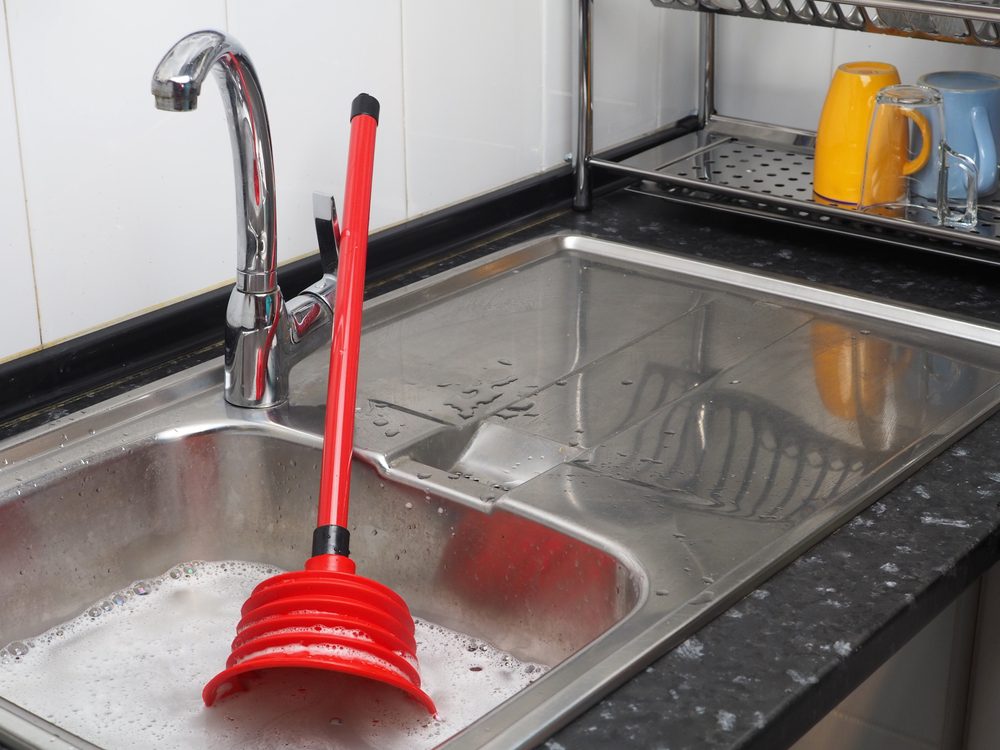
How to Unclog a Kitchen Drain
A clogged drain in your kitchen is different from a clogged bathroom sink or shower drain. Instead of clotted hair or built-up soap residue, the usual causes for a clogged drain in your kitchen are an accumulation of grease or food fragments in the sink trap. The solution to fixing a grease clogged kitchen sink involves differing methods.
Homemade Drain Cleaner
- Try to dissolve kitchen grease or food clogs by pouring 1/2 cup baking soda down the drain, followed by 1/2 cup of white vinegar.
- Cover with a stopper or wet rag and wait about 10 minutes.
- Flush with boiling water.
It’s best to avoid caustic chemicals since they’re bad for the environment and your health. If you must use something, look for an alternative product that contains microorganisms that eat the material causing the clog, converting it to water and carbon dioxide.
Plunge the Drain
- If you’re unclogging a double sink, seal the other sink opening with the sink stopper or a wet washcloth, otherwise, the plunging will not be effective.
- Add a few inches of hot water to the sink.
- Position the bell of the sink plunger directly atop the clogged drain opening.
- Plunge vigorously with a straight up and down motion for a minute, then remove the plunger.
- If the sink doesn’t drain, try again.
- Still no luck? Try clearing the clog with a drain snake next. If you’re DIY capable, move on to disassembling the trap under the sink via the steps below.
Use a Drain Auger
- Tough clogs may require the use of a drain auger/drain snake.
- Feed the auger down the drain until you meet resistance.
- Steadily push through the blockage while rotating the auger.
- Push and pull the tool to expand the hole and break up the clog material.
- Flush with water.
Clean the Trap
- Place a bucket beneath the U-shaped trap in the drainpipe under the sink.
- Loosen the two large slip nuts that secure the trap in the pipe. If they can’t be loosened by hand, be careful not to apply too much force with a wrench–call your plumber to handle the job if they’re stubborn.
- Pull downward gently to remove the trap from the sink tailpiece, then pull it off the drainpipe leading into the wall.
- Clean grease, food scraps, and other debris out of the trap and reinstall.
- Hand-tighten the slip nuts securely, then run water and check for leaks.
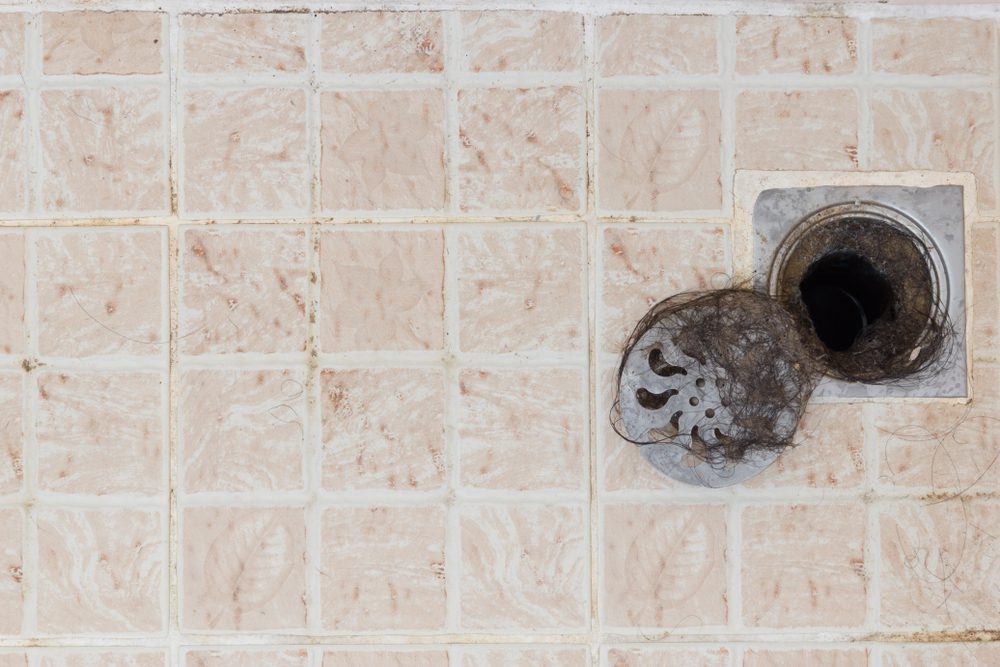
How to Unclog a Shower Drain
Hair and soap scum are common culprits of shower drain clogs. Follow these steps to clear a plug in your shower or bathtub.
- Take out the drain stopper or remove the screen.
- Look into the drain to see if the clog is visible and near the opening. If so, reach in with your fingers, pliers, or a piece of wire to pull out the clog.
- If you are unable to reach the clog this way, it’s time to plunge the drain. Position a cup plunger atop the drain and make a seal.
- Fill the tub with a few inches of water–enough to reach the top of the plunger’s cup.
- Pump the plunger up and down, swift and hard to loosen the clog via the vacuum produced by plunging.
- If the water flows through the drain once the plunger is removed, the clog has resolved. If not, move on to use the drain snake.
- Insert the snake into the drain opening, feeding it through until you hit the clog.
- Twist and push the snake through the clog material. Push and pull it back and forth to break up the clog.
- Remove the snake, pulling the clog material along with it, if possible.
- Flush the drain with hot water to move the broken-up clog material through the drain line.
Steps for Preventing a Clogged Drain
The best method for clearing a drain is to prevent the issue in the first place. These preventive tips help homeowners treat their drains right and avoid clogs.
- Avoid fats and grease. Liquid fats like oil and butter go down the drain easily with hot water but start to solidify further down the drainpipe as they cool. Other debris, like coffee grounds and food particles, adhere to the fats until the pipe is impassable. Avoid this situation by draining grease and oil into a tin can or glass jar and then disposing of it in the garbage.
- Use a drain screen. Hair and soap scum are two of the leading causes of clogs in bathroom drains. Prevent these from entering your drain by installing an inexpensive screen.
- Pour boiling water down the drain. Doing this once a week can go a long way toward keeping them open and clog free.
- Avoid using chemical drain cleaners. These corrode your pipes and cause leaks over time. Choose natural alternatives instead.
- Don’t flush foreign objects down the drain. Many disposable cosmetic items used in the bathroom should not be disposed of down the drain. Facial tissue, cotton balls, and Q-tips do not degrade inside the drainpipe. Instead, they form a clog that requires the services of a plumber to clear.
- Maintain the drain. Monthly use of enzyme-based drain maintenance products (not caustic drain openers) helps dissolve drain-clogging substances and prevent clogs on an ongoing basis. If you don’t want to go to the trouble of using these products, try this natural drain maintenance technique: Once a month, pour a cup of baking soda down the drain followed by one cup of vinegar, added slowly. Wait five minutes, then flush the drain with a gallon of boiling water.
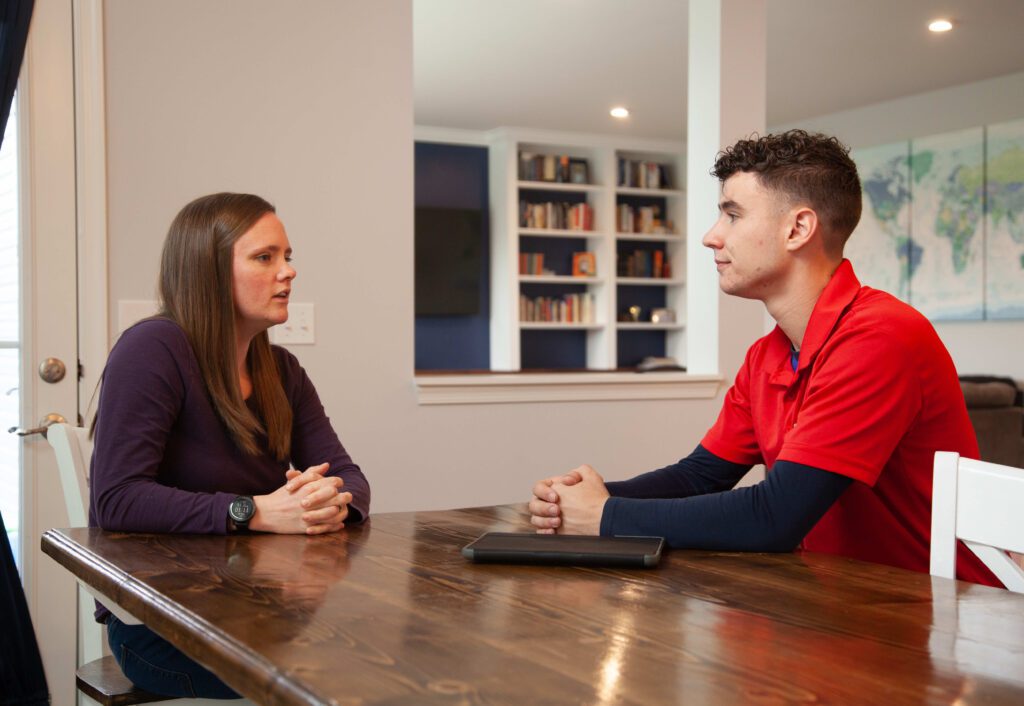
My Drain Is Still Clogged, Now What?
If you can’t fix your clogged drain, it’s time to call a pro. Trust the licensed Cincinnati plumbers of Apollo Home to effectively clear clogs and restore proper drainage throughout your home. Contact us today to schedule drain clearing and drain cleaning services for your home.


